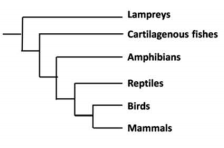 Multiple Choice Questions
Multiple Choice QuestionsMost members of bryophyte phylum Anthocerophyta are characterized by
gametophyte with single chloroplast per cell and multicellular rhizoids; sporophyte without stomata.
gametophyte with single chloroplast per cell and unicellular rhizoids; sporophyte with stomata.
gametophyte with multiple chloroplasts per cell and unicellular rhizoids; sporophyte with stomata.
gametophyte with single chloroplast per cell and multicellular rhizoids; sporophyte with stomata.
Alveolar cells of the lung arise from which one of the following layer (s)?
Mesoderm
Endoderm
Ectoderm
Both ectoderm and endoderm
In chick, development of wing feather, thigh feather, and claws depends on epithelial specificity conferred by induction from mesenchymal components from different sources of the dermins. This may be attributed to?
Autocrine interaction
Regional specificity of induction
Receptor activation by hormones
Inactivation of genetic interactions
For the following invertebrate structures/ organs, identify their major function and the animal group in which they are found:
Nematocyst (A), Protonephridia (B), Malpighian tubules (C), Radula (D)
A - Porifera, Skeletal support; B - Mollusca, excretion; C - Insecta, respiration; D - Anthozoa, prey capture
A - Anthozoa, prey capture; B - Planaria, excretion; C - Mollusca, excretion; D - Insecta, food processing
A - Planaria, excretion; B - Mollusca, respiration; C - Insecta, respiration; D - Porifera, prey capture
A - Anthozoa, prey capture; B - Planaria, excretion; C - Insecta, excretion; D - Mollusca, food processing

With reference to the phylogenetic tree presented above, which of the following statements is true?
Amphibians, reptiles, birds, and mammals share a common ancestor.
Birds are more closely related to reptiles than to mammals.
Cartilaginous fishes are the ancestors of amphibians.
Lampreys and mammals are not related.
Based on the table given below, which of the following option represents the correct match?
| Category | Plant species |
| A. Critically endangered | i. Chromolaena odorata |
| B. Vulnerable | ii. Dipterocarpus grandiflorus |
| C. Extinct | iii. Euphorbia mayuranthanii |
| D. Invasive | iv. Saraca asoka |
A - i; B iv; C - iii; D - ii
A - ii; B - iii; C - iv; D - i
A - i; B - iv; C - ii; D - iii
A - ii; B - iv; C - iii; D - i
A person showed the symptoms of diarrhea, gas and pain whenever milk was consumed. The doctor advised the person to take curd instead of milk and subsequently the symptoms of mostly disappeared due to this change of dairy product. The following statements are proposed to explain this observation:
A. The person has deficiency in the intestinal sucrase-maltase.
B. Curd is not deficient in sucrose and maltose.
C. The person has deficiency in the intestinal lactase.
D. The bacteria in curd contain lactase.
Which one of the following is true?
A only
A and B
C only
C and D
Which of the following is wild relative of wheat?
Triticum monococcum
Triticum compactum
Triticum vulgare
Triticum boeoticum
Which of the following is NOT an attribute of a species that makes it vulnerable to extinction?
Specialized diet
Low dispersal ability
Low trophic status
Variable population density
C.
Low trophic status
Low trophic status is not an attribute of a species that makes it vulnerable to extinction.
Match the following larval forms with the phyla that they occur in
| Larva | Phylum |
| a. Amphiblastula | i. Mollusca |
| b. Nauplius | ii. Echinodermata |
| c. Glochidium | iii. Porifera |
| d. Bipinnaria | iv. Arthropoda |
| v. Annelida |
a - iii; b - iv; c - i; d - ii
a - iv; b - iii; c - i; d - v
a - ii; b - v; c - iv; d - i
a - v; b - i; c - ii; d - iii
